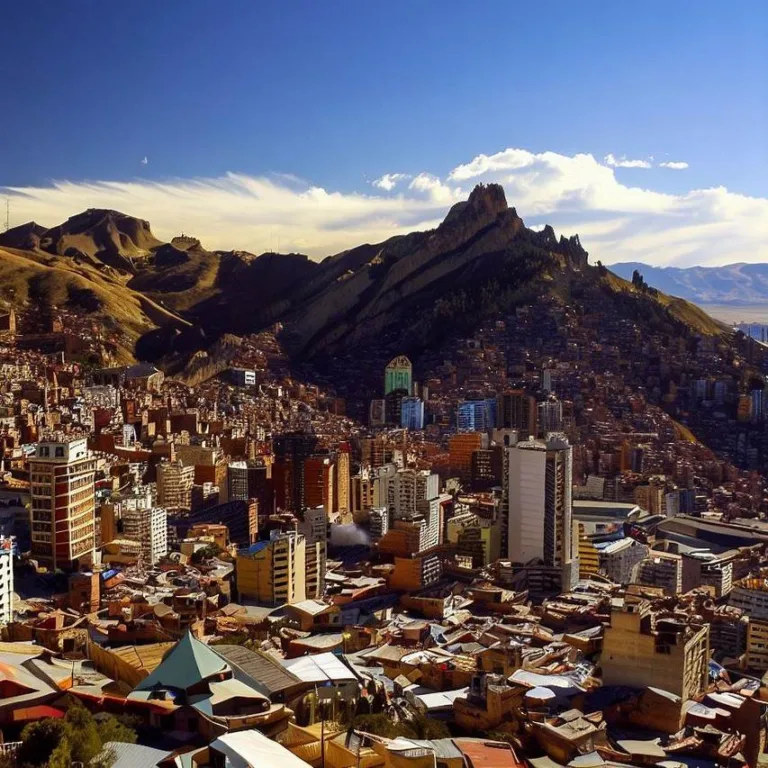La Paz, the bustling capital of Bolivia, is a city that seamlessly blends tradition and modernity, offering visitors a unique and captivating experience. Nestled high in the Andes Mountains, La Paz boasts breathtaking landscapes, a rich cultural heritage, and a vibrant atmosphere. In this article, we’ll take you on a virtual journey through this extraordinary city, exploring its history, culture, attractions, and much more.
The historical tapestry of la paz
La Paz has a rich and complex history that dates back to its founding in 1548. Originally established by Spanish conquistadors as a mining town, the city has evolved over the centuries, becoming a melting pot of indigenous, European, and mestizo cultures. Its historical significance is evident in its well-preserved colonial architecture, narrow winding streets, and numerous museums.
Colonial Charms
Walking through the historic center of La Paz feels like stepping back in time. The city’s colonial-era buildings, such as the San Francisco Church and the Presidential Palace, are architectural gems that transport visitors to a bygone era. The intricate facades and ornate interiors of these structures are a testament to the craftsmanship of the time.
Indigenous Heritage
La Paz is also a stronghold of indigenous culture, with many Aymara and Quechua communities residing in and around the city. Visitors have the opportunity to engage with these communities, learn about their traditions, and even purchase handcrafted goods at local markets, such as the Witches‘ Market.
Modern marvels and cultural delights
While La Paz cherishes its history, it is also a modern metropolis that offers a wide range of experiences for travelers. The city’s thriving arts scene, culinary delights, and vibrant nightlife are sure to leave a lasting impression.
Art and Museums
Art enthusiasts will be delighted by La Paz’s numerous galleries and museums, including the National Museum of Art and the Museum of Contemporary Art. These institutions showcase both traditional and contemporary Bolivian art, providing insight into the country’s creative spirit.
Gastronomic Adventures
Food lovers can embark on a culinary journey through La Paz, savoring traditional Bolivian dishes like salteñas (savory pastries) and llama meat. The city also offers international cuisine, making it a gastronomic paradise for all tastes.
Nightlife and Entertainment
As the sun sets, La Paz comes alive with a vibrant nightlife. From trendy bars and clubs to live music venues, there’s something for everyone to enjoy after dark. The city’s nightlife is a reflection of its youthful energy and zest for life.
Adventures in the andes
La Paz’s unique geography, nestled in a high-altitude valley, offers outdoor enthusiasts a plethora of adventure opportunities. The surrounding Andes Mountains provide the backdrop for unforgettable experiences.
Mountain Treks
Adventure seekers can embark on exhilarating treks in the nearby Cordillera Real, home to some of the world’s highest peaks. Hiking to places like Huayna Potosí and Illimani offers not only physical challenges but also breathtaking views of the Andean landscape.
Mountain Biking
For those with a passion for mountain biking, the Death Road (Camino de la Muerte) is a thrilling yet daring choice. This iconic route takes riders from high-altitude cliffs down to the lush Yungas rainforest, providing an adrenaline rush like no other.
Frequently asked questions
1. Is La Paz safe for tourists?
La Paz is generally safe for tourists, but like any city, it’s essential to take precautions. Avoid displaying valuable items, be cautious at night, and use reputable transportation services.
2. What’s the best time to visit La Paz?
The best time to visit La Paz is during the dry season, which typically runs from May to October. During this period, the weather is more stable, making it ideal for outdoor activities.
3. How do I acclimatize to the high altitude?
It’s crucial to acclimatize gradually to the high altitude of La Paz. Rest and hydrate upon arrival, avoid strenuous activities on your first day, and consider medications like acetazolamide if needed.
4. Can I visit nearby attractions from La Paz?
Absolutely! La Paz serves as a great base for exploring nearby attractions like the ancient ruins of Tiwanaku, the stunning Moon Valley (Valle de la Luna), and the picturesque town of Copacabana on Lake Titicaca.
5. What’s the currency in La Paz?
The currency used in La Paz is the Bolivian Boliviano (BOB). It’s advisable to have some cash on hand, although credit cards are widely accepted in many establishments.
In conclusion, La Paz is a city of contrasts, where the past and present coexist harmoniously. Its rich history, cultural diversity, and natural beauty make it a destination worth exploring. Whether you’re an adventure seeker, a history buff, or a food lover, La Paz has something to offer every traveler.
Viz také:






